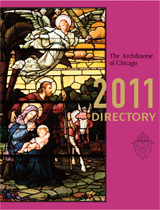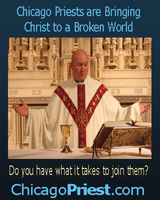Parishes emphasize sacramental tone for weddings

A regular feature of The Catholic New World, The InterVIEW is an in-depth conversation with a person whose words, actions or ideas affect today's Catholic. It may be affirming of faith or confrontational. But it will always be stimulating.
Wedding bells are in the air in June — and every other month of the year, at some Chicagoarea parishes. Old St. Patrick’s in the West Loop and St. Clement in Lincoln Park, both of which have many young adults in their congregations, have multiple weddings nearly every weekend of the year. Catholic New World assistant editor Michelle Martin spoke with Father Ramil Fajardo, St. Clement’s associate pastor, and JoAnn Meyer, Old St. Pat’s wedding coordinator, to find out how they keep the emphasis on the sacrament of matrimony on a day that could get overwhelmed by the details.
Catholic New World: How many weddings do you have here? Do you accommodate couples who are not parishioners?
Father Ramil Fajardo: We have about120 weddings a year, possibly more. I average about 35-40 weddings a year myself. We celebrate weddings only for parishioners. We’re booked solid.
JoAnn Meyer: Old St. Pat’s has 150-200 weddings a year, meaning there are at least three nearly every weekend, and five on the busiest weekends. The parish welcomes non-parishioners who want to celebrate their weddings there.
CNW: How far in advance do people have to reserve a date?
Meyer: Most people know that about a year and a half is a normal time frame, maybe a year to a year and a half. We do have some people who want to come in and get married in 6 months. If they can meet the requirements, we do our best to accommodate them.
Fajardo: We always emphasize that it should be started minimally six months before, but with most people we have them come in nine to 12 months before the wedding.
CNW: What’s the first thing you do when people call about scheduling a wedding?
Fajardo: We invite them to a wedding information night. At the information night, we go over the policies. First, we remind couples all the time that it’s about a marriage, and the wedding is not the marriage. It’s about faith, it’s about mutual respect and love. Then we go into the details of the actual marriage preparation. Secondly, we review pre-Cana, and we emphasize this is ongoing formation in your faith life. This is about us helping you have the best possible tools to enter into your marriage as a faithfilled couple.
Thirdly, there is the prenuptial interview, that we do as priests. It is not so much an interview as it is encouragement, as a faith review. We talk about love, and the very words of the sacrament are very important. We talk about life in general where Christ has a place. We try to defuse all the splendor of the day and really all of the heartache and pain that comes with it. You’ve got the food-tasting, the dress, the caterer, all those things. We try to relax them enough to say, you know what? Everything can look perfect, but marriage is what happens the next day, and how do you understand your integrity, your dignity as husband and wife, as man and woman? We emphasize that love really is a calling.
Meyer: The very first thing we do is make them feel welcome and set the tone for a happy experience to come. We want them to know it will be a very easy process, and we will keep it as simple as possible.
We have a list of requirements — things you have to do to be married in the Catholic Church. But we reassure them that it’s not difficult; for example, getting a copy of your baptismal certificate just means getting in touch with the church where you were baptized. We have a Web site that has all the information, and I can e-mail them most of the forms.
Once the date is set, we have a planning guide — about a 30-page book. It takes them from the engagement through to the ceremony. Then about six weeks before the ceremony, we sit down to focus on that. That is the most important part of the wedding.
We have a detailed worksheet for the ceremony. They can choose their own music, as long as it is respectful and appropriate. They can choose their readings, and they can work with their individual priest on anything else they want, how they want the bridal party placed on the altar, any cultural traditions their family observes, all those things we can work on. Anything to make them feel at home and honor friends, family and tradition.
CNW: What’s non-negotiable?
Meyer: A Catholic priest must conduct the Mass. They have to say the vows and sign the certificate and have it witnessed. There are certain elements that have to be in the ceremony, but it can be part of the Mass or just a simple ceremony. If it is a Mass, they can have the Sacrament [of the Eucharist] under both species, or they can have the Sacrament as the bread only. They can receive the gifts. There’s a lot of areas where we can personalize the ceremony.
Fajardo: It’s pretty standard. It is pretty restrictive, like the cathedral and some of the other churches. It’s a pretty formal church. For example, runners. We had a grandma trip, and we decided that’s the end of runners. We have the nice terrazzo floors.
There’s also the aspect of good stewardship and where people are putting their resources. Maybe it would be better to save the money on some of these things and spend it on the reception or save it for the honeymoon. When you have a church like St. Clement, which is lavish enough already, you really don’t need that much more. So that gives us an opportunity to talk about stewardship, and also about what is the proper setting for your wedding. The wedding itself is about the words you are about to speak: “I promise to be true to you in good times and in bad.” It all comes down to that, and everything else is pure decoration.
I’m a firm believer in the idea of John Paul and the idea of personalism. It’s about my person encountering God, and I try to say that you, John and Mary, are persons, and you are encountering God not only in one another, but here, in the sacrament, and here, in the sacrament of the community. So you don’t need stuff. Let’s talk about where do you apprehend God? You should do that in each other, in the words, in the community, in the church building.
CNW: How do people react to the requirements?
Fajardo: When we’re sitting in this room doing the interview, they take it seriously. They appreciate the faith. Even the non-Catholics and even the non-Christians — there are mixed marriages here — they do appreciate it. To hear what the church teaches as far as love, honor, respect, fidelity, all those things resonate. The issue is encouraging them to make sure they don’t get snuffed out by the issues of daily life. They need to stay in the presence of God, stay close to God. My role here is to make sure that the flame of faith doesn’t get extinguished by stuff.
A lot of humor is necessary, not only the day of the wedding, but in the interview, the faith formation. A good sense of humor is so important in any relationship. You’ve got to laugh at yourself and each other. We’re not Jansenists, we’re not sour people. I try to emphasize to people we need to have a sense of joy and hope in life.
Meyer: We explain that this is a sacrament, and we ask them to fulfill these requirements because it is a sacrament. It will enrich their lives and bring grace into their marriage.




